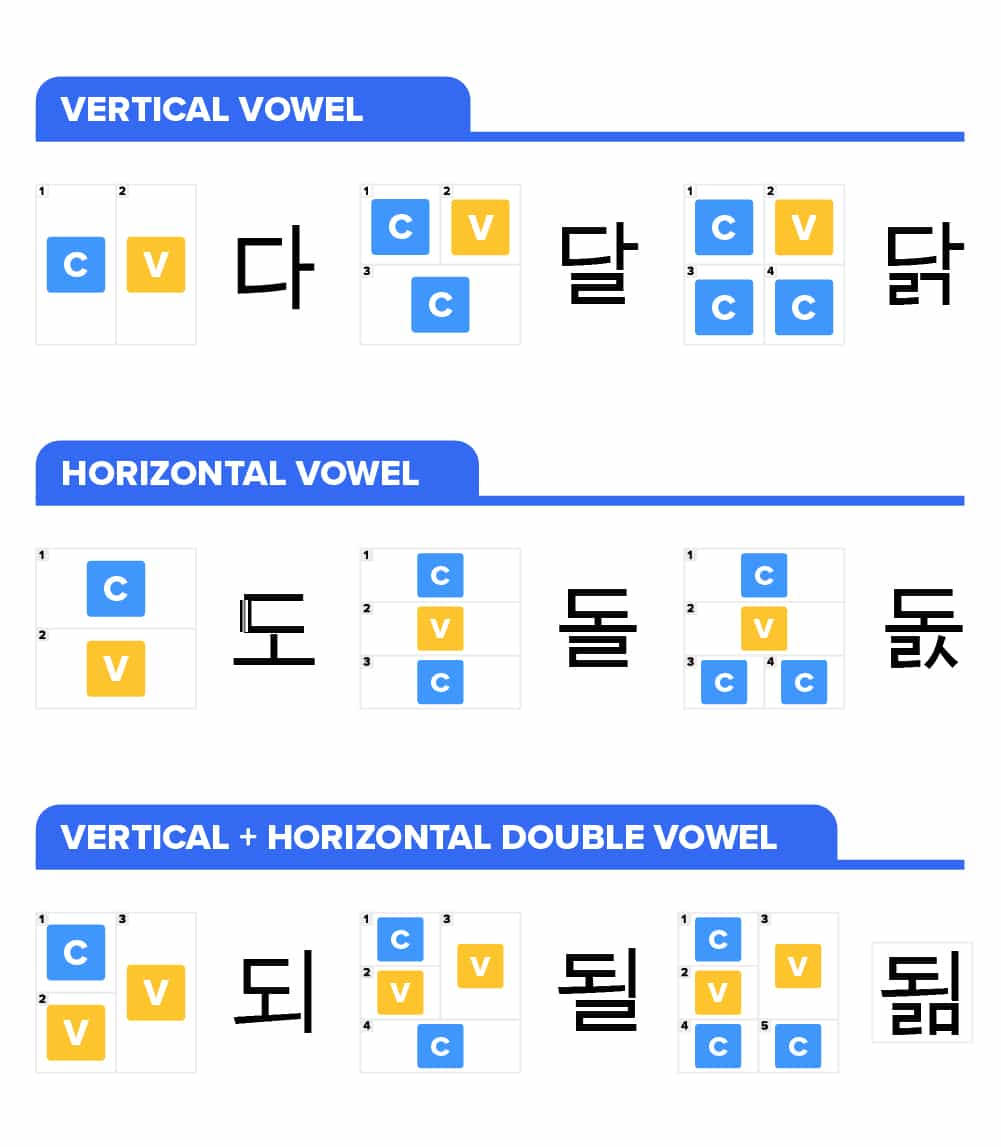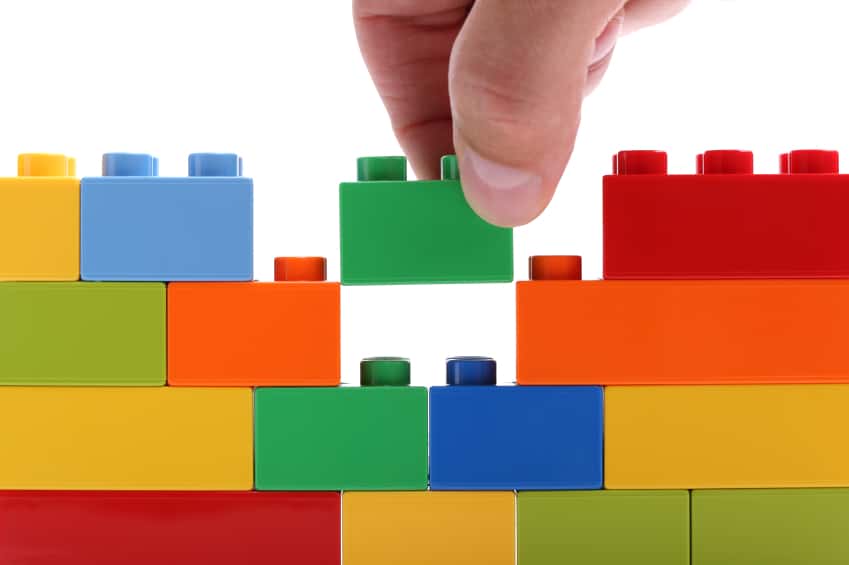
Learn Korean Syllable Structure, Order and Pronunciation [3 Steps]
The Korean writing system was intentionally crafted to be simple, easy to learn and to precisely capture the sounds of spoken Korean.
It follows an elegant process: structuring small geometric letters into full syllables.
Due to its simplicity and logic, I’ll be able to teach you the Korean syllable structure in a quick, three-step guide, even if you’re starting from zero.
(Though, if you are starting from zero, I recommend checking out our starter guide to the Korean alphabet as well.)
Hangul | The Korean Alphabet | FluentU Korean
If you want to learn Korean, the best place to start is with the Korean alphabet! Hangul is a super straightforward writing system, so read this guide to find all about…
Contents
- 1. The Structure of Korean Syllables
- 2. The Order of Korean Syllable Letters
- 3. The Pronunciation of Korean Syllables
- Basic Korean Syllable Combinations
- And One More Thing...
Download: This blog post is available as a convenient and portable PDF that you can take anywhere. Click here to get a copy. (Download)
1. The Structure of Korean Syllables
Think of Korean syllables as building blocks or bricks.
Each brick fits a minimum of two and a maximum of four Hangul letters. The letter combinations will include both consonants and vowels—you can’t make a syllable without the two.
Here are the main consonants and vowels in Hangul:
Consonants ㄱ,ㄴ,ㄷ,ㄹ,ㅁ,ㅂ,ㅅ,ㅇ, ㅈ, ㅊ, ㅋ, ㅌ, ㅍ and ㅎ Vowels ㅏ, ㅑ, ㅓ, ㅕ, ㅗ, ㅛ, ㅜ, ㅠ,ㅡ andㅣ
The factors that affect Korean syllable structure
The structures of Korean syllables are affected by the letters they involve. Whichever Hangul letters are needed, results in the written structure of the syllable changing.
When written, Korean syllables should fit neatly within a rectangular or square outline—a nice and simple shape. But what actually goes within that square?
The number of letters is one factor. Two-letter syllables take up forms different from three or four-letter syllables.
Here are a few examples:
As you can see, the more letters contained within the square, the tighter the syllable block becomes in order to uniformly fit each letter. But the boundary is still obeyed.
In Hangul, double consonants exist, which are ㄲ, ㄸ, ㅃ, ㅆ, and ㅉ. There are also vowel combinations that work as one. Both double consonants and double-vowel combos count as single letters.
The vowels ㅘ, ㅙ, ㅚ, ㅟ, ㅝ, ㅞ, and ㅢ are combos that contain both vertical and horizontal vowels— resulting in each wrapping around a consonant so that it sits above the first vowel making up the combo.
Dependent upon which vowels are used is the second factor that affects the structure of syllables.
The vertical vowels enable syllables to be written from left to right to the bottom. Essentially, a syllable is written in a clockwise fashion. The vowels are placed adjacent to the consonant.
Horizontal vowels enable syllables to be written from top-to-bottom. They are placed under the consonants.
Together, both consonants and vowels take up the top space of a syllable block. The rest of the letters in the syllable occupy the bottom space.
Here are a few examples of how the vowel can affect the syllable structure:
These are the primary factors that will decide how a syllable appears. The visual component to this will make much more sense the longer you speak, read, and write Korean text.
2. The Order of Korean Syllable Letters
Let’s talk about some additional rules regarding the order of Korean syllable letters.
The positions of consonants and vowels in Korean syllables
Consonants and vowels belong in very specific positions within a syllable.
- The first letter is always a consonant (can be referred to as the initial consonant).
- The second letter is always a vowel (which can be adjacent to, under, or wrapped around the first letter).
- The third letter is always a consonant (which will be under both the first and second letters).
- The fourth letter is always a consonant (which will be adjacent to the third letter).
The third and fourth letters of a syllable occupy the “bottom bunk” of a syllable. This position actually has a special name: 받침 (bat-chim), which literally and fittingly means “support.”
This order also applies to how you should progress in actually writing the syllable.
Two-letter syllables
The second letter is always a vowel and can be written to the right of, under or wrapped around the first letter consonant.
- 우 = initial consonant ㅇ + vowel ㅜ
- 웨 = initial consonant ㅇ + vowel ㅞ
- 겨 = initial consonant ㄱ + vowel ㅕ
- 따 = initial consonant ㄸ + vowel ㅏ
Three-letter syllables
The third letter is always a consonant and is written under the initial consonant and the second letter vowel.
- 순 = initial consonant ㅅ + vowel ㅜ + consonant ㄴ
- 획 = initial consonant ㅎ + vowel ㅚ + consonant ㄱ
- 빵 = initial consonant ㅃ + vowel ㅏ + consonant ㅇ
Four-letter syllables
The fourth letter is always a consonant and will be right next to the third letter. Together, they form the syllable’s 받침.
- 삶 = initial consonant ㅅ + vowelㅏ + consonant ㄹ + consonant ㅁ
- 찮 = initial consonant ㅊ + vowelㅏ + consonant ㄴ + consonant ㅎ
- 값 = initial consonantㄱ + vowelㅏ + consonant ㅂ + consonant ㅅ
Here’s a nifty graphic to show you how it all works:
3. The Pronunciation of Korean Syllables
So far, I’ve focused primarily on the written aspect of syllables. But what about actually pronouncing them?
Korean pronunciation is pretty matter-of-fact. Once you become familiar with properly enunciating Korean sounds, then you’ll soon master pronouncing full Korean words.
You can get a head start on this by getting in some listening practice with real Korean media, like that on FluentU.
FluentU takes authentic videos—like music videos, movie trailers, news and inspiring talks—and turns them into personalized language learning lessons.
You can try FluentU for free for 2 weeks. Check out the website or download the iOS app or Android app.
P.S. Click here to take advantage of our current sale! (Expires at the end of this month.)
For this guide, I’m focusing on Korean syllable pronunciation that you’ll use more frequently as a beginner learner—based on 받침—the one or two bottom consonants of a syllable.
Because the Korean language is syllable-timed, not stress-timed, there’s typically no extra emphasis given to any specific syllable while you’re speaking.
That being said, there are just a few little quirks about syllable pronunciation that are worthwhile to mention. They’re especially important to note if you want to sound like a native speaker.
The special pronunciation of certain 받침
Now, the 받침 can sometimes be a bit finicky in its pronunciation. Sometimes, you can’t really trust a syllable’s 받침 when you only hear the syllable and don’t see it in written form.
When a syllable’s 받침 is ㅅ, ㅆ, ㅈ, or ㅊ then those letters take on the ㄷ sound.
Here’s this rule in action:
There’s also another pronunciation rule regarding four-letter syllables and 받침.
A four-letter syllable has two consonants working double-time as the 받침. However, something interesting happens to one of the bottom consonants.
When spoken by itself, a four-letter syllable can sometimes become silent with one of its 받침 consonants.
So, in the following examples:
- 없 isn’t pronounced as ups, but instead, 업 (up)
- 닭 isn’t pronounced as dalk, but instead, 닥 (dak)
- 읷 isn’t pronounced as iks, but instead, 익 (ik)
It’s usually the second of the 받침 consonants that’s silent. But there are special circumstances in which the first consonant is silent instead.
So, you wonder, what’s the point of that consonant that’s essentially losing its voice?
Don’t worry, it makes its appearance following a syllable that starts with the silent consonant ㅇ.
The effect of 받침 when followed by a silent consonant syllable
The silent consonant ㅇ is actually considered more of a “placeholder” consonant. It doesn’t contribute its own sound. A syllable that has ㅇ as its initial consonant, takes on the sound of the following vowel.
But the rules dictate a consonant must be the first letter in a syllable.
When a syllable is followed by a syllable starting with ㅇ, then the first syllable’s 받침 shifts its sound to that second syllable.
That’s right. One syllable’s 받침 can effectively manipulate its own sound onto the following silent consonant syllable. In this instance, you’ll want to pay more attention to your pronunciation.
In addition, the silent consonant in four-letter syllables can also make its return.
Here’s this rule in action:
You’ll find the syllables roll off the tongue much more naturally with this rule.
The effect of 받침 adjacent to other consonant syllables
Ready for a mind-bending tongue twister?
If one syllable has a consonant as 받침, and the next syllable starts with a consonant sound excluding the silent consonant, then the second consonant can have an exaggerated pronunciation.
Still with me?
That’s right. 받침 once again makes its appearance, even when followed by consonants other than ㅇ.
This is most notable if a syllable’s 받침 is the same consonant as the initial consonant of the following syllable. Think of it as a “layering” effect.
It’s also quite noticeable when the consonants ㄱ, ㄷ or ㅂ are involved.
Here are some examples:
- 맞다 is pronounced more like 맞따 (mat-dda). Remember, the ㅈ in 받침 position takes the ㄷ sound.
- 책상 is pronounced more like 책쌍 (check-ssang).
The exaggeration itself can seem a bit subtle to the untrained ear. Listening to Korean audio, whether it’s catchy K-pop music or captivating audiobooks, can be very helpful.
And as I mentioned earlier, there are many more guidelines for consonant-consonant interactions.
For instance, if a syllable has ㄹ as its 받침, and it’s followed by a syllable that starts with consonant ㄴ, then that second syllable swaps the ㄴ sound for the ㄹ sound.
You’ll often hear 잘나 pronounced as 잘라 (jal-lah) by Korean natives.
Why? Because it makes for easier phonetics but can create more head-scratching for beginner learners.
Basic Korean Syllable Combinations
Were you able to catch all that? For some basic consonant and vowel combinations, plus how to pronounce them, check out this table below.
ㅏ ㅑ ㅓ ㅕ ㅗ ㅛ ㅜ ㅠ ㅡ ㅣ ㄱ 가 갸 거 겨 고 교 구 규 그 기 ㄴ 나 냐 너 녀 노 뇨 누 뉴 느 니 ㄷ 다 댜 더 뎌 도 됴 두 듀 드 디 ㄹ 라 랴 러 려 로 료 루 류 르 리 ㅁ 마 먀 머 며 모 묘 무 뮤 므 미 ㅂ 바 뱌 버 벼 보 뵤 부 뷰 브 비 ㅅ 사 샤 서 셔 소 쇼 수 슈 스 시 ㅇ 아 야 어 여 오 요 우 유 으 이 ㅈ 자 쟈 저 져 조 죠 주 쥬 즈 지 ㅊ 차 챠 처 쳐 초 쵸 추 츄 츠 치 ㅋ 카 캬 커 켜 코 쿄 쿠 큐 크 키 ㅌ 타 탸 터 텨 토 툐 투 튜 트 티 ㅍ 파 퍄 퍼 펴 포 표 푸 퓨 프 피 ㅎ 하 햐 허 혀 호 효 후 휴 흐 히
So that’s the gist of Korean syllables!
To build confidence and skill, you can always check your Korean grammar to help you master the Korean syllable structure more easily.
Have fun constructing those little language building blocks. Soon enough, you’ll be able to form full-on Korean sentences and phrases, and really get talking!
Download: This blog post is available as a convenient and portable PDF that you can take anywhere. Click here to get a copy. (Download)
And One More Thing...
If you enjoyed this post, you're already halfway to having the time of your life learning Korean with FluentU!
FluentU makes it possible to learn with K-pop videos, funny commercials, entertaining web series and more. Just a quick look will give you an idea of the variety of FluentU videos on offer:
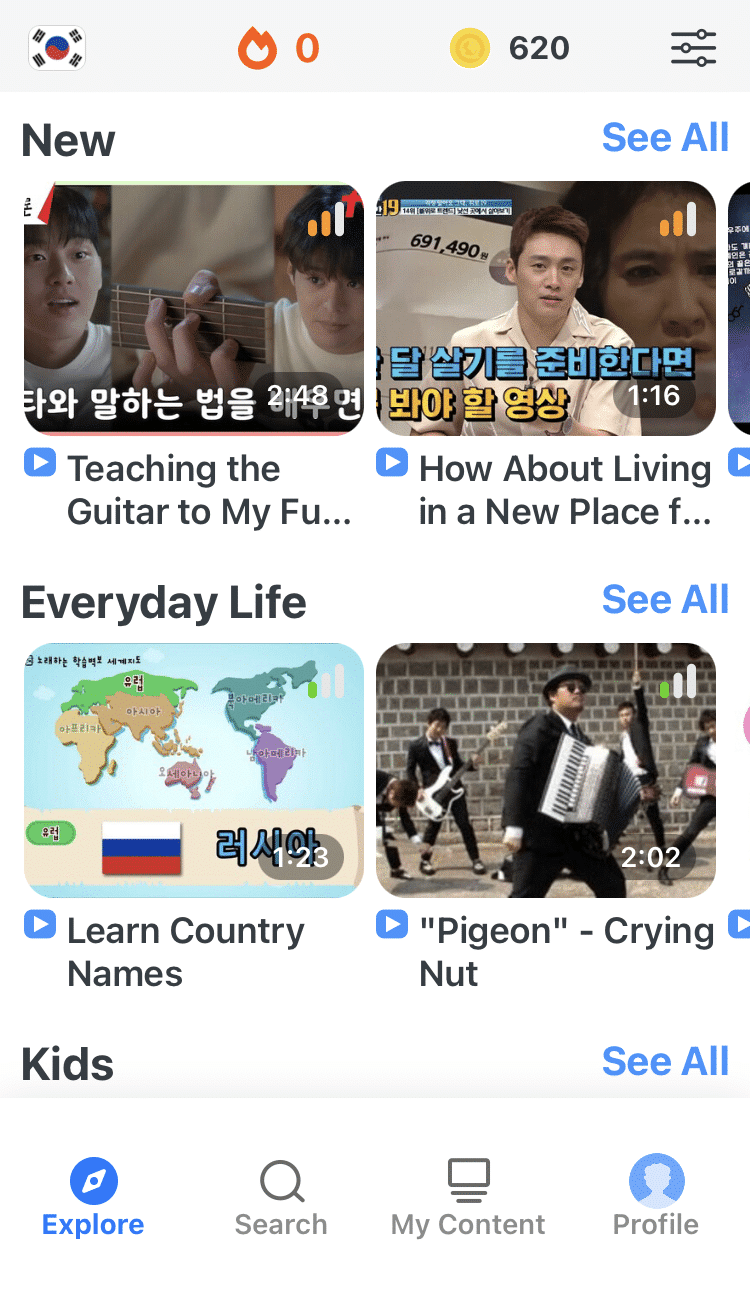
FluentU really takes the grunt work out of learning languages, leaving you with nothing but engaging, effective and efficient learning. It's already hand-picked the best videos for you (which are organized by level and topic), so all you have to do is simply choose any video that strikes your fancy to get started.
Each word in the interactive captions comes with a definition, audio, image, example sentences and more.
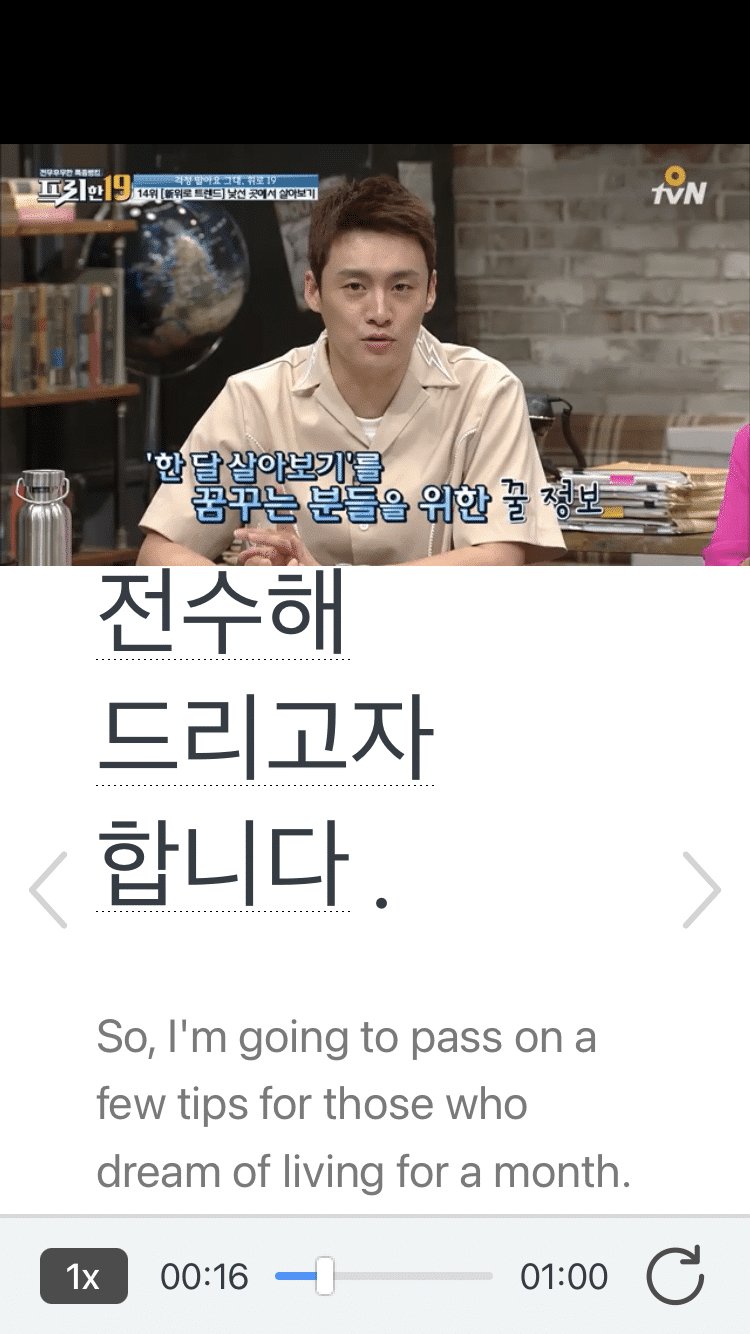
Access a complete interactive transcript of every video under the Dialogue tab, and easily review words and phrases from the video under Vocab.
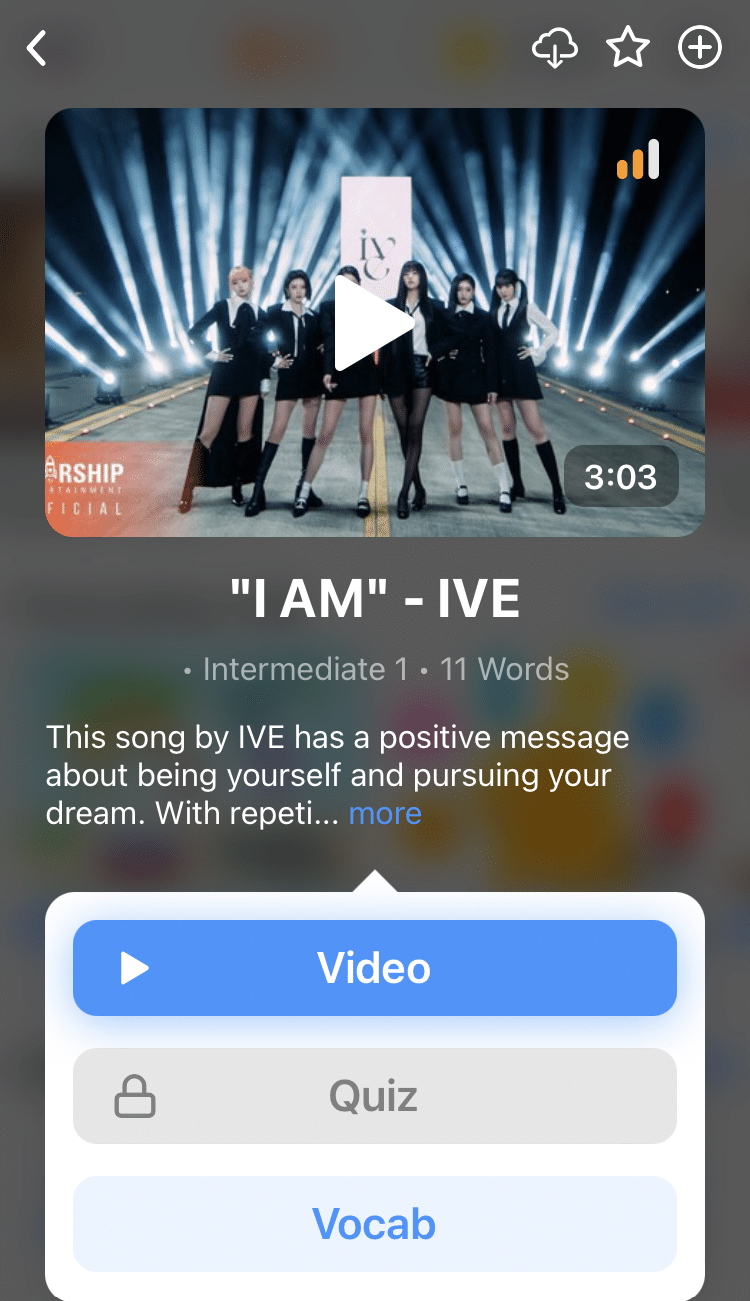
You can use FluentU’s unique Quiz Mode to learn the vocabulary and phrases from the video through fun questions.
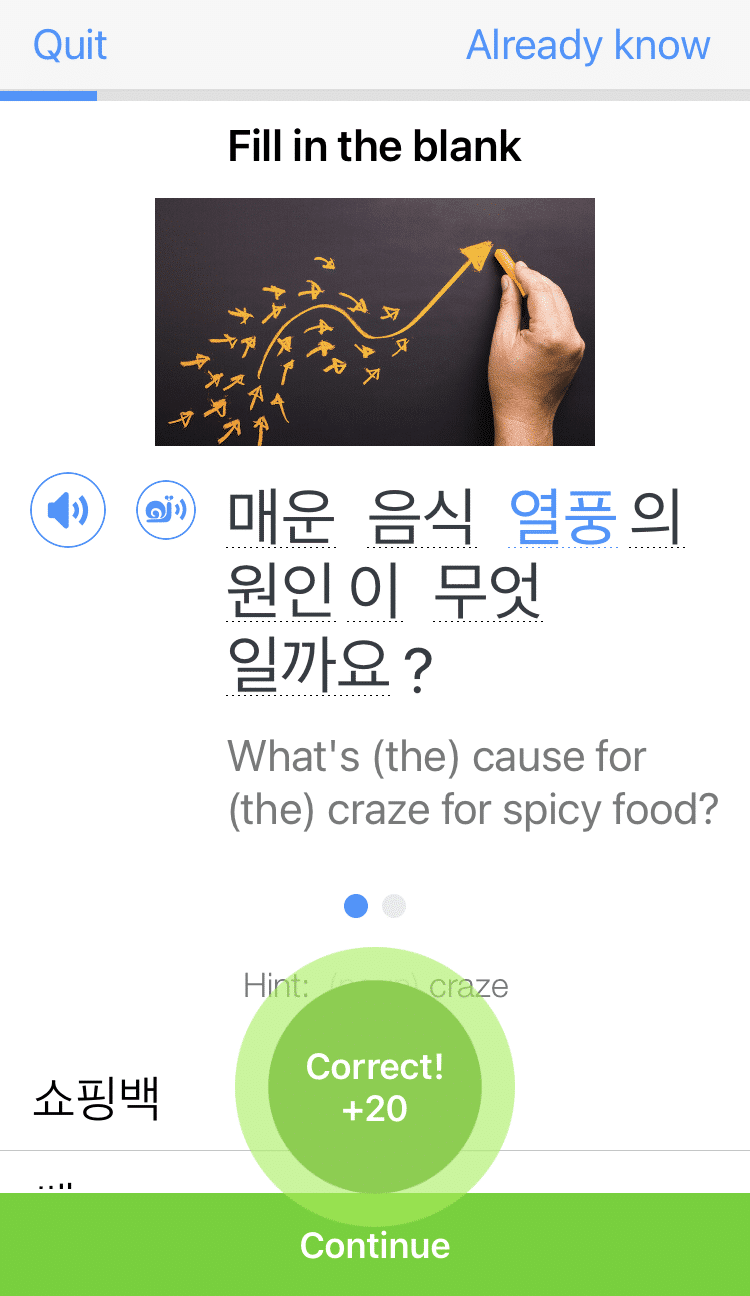
FluentU keeps track of what you're learning, and tells you exactly when it's time for review, giving you a 100% personalized experience.
Review sessions use video context to help embed the words in your memory.
Start using the FluentU website on your computer or tablet or, better yet, download the FluentU app from the iTunes or Google Play store. Click here to take advantage of our current sale! (Expires at the end of this month.)
